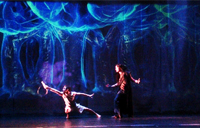Traditionally, the play is presented as a light-hearted comedic romp, sprinkled with fantasy and romantic misadventure. Under the direction of theatre MFA candidate Alison Humphrey, York’s Dream gives the magical tale a cutting-edge makeover, both literary and technological. Dream and nightmare converge through dazzling special effects created through sophisticated motion-capture and projection technology, and an innovative interpretation of the text that mines the darker undercurrents in the script.
A Midsummer Night’s Dream opens with Duke Theseus telling his fiancée, the queen of the Amazons, “I wooed thee with my sword, and won thy love doing thee injuries.” He is interrupted by a father storming in, demanding that the duke allow him to kill his daughter if she will not marry the man he has chosen. Later, the fairy Puck reports that his queen Titania has “a lovely boy,  stolen from an Indian king; she never had so sweet a changeling.”
stolen from an Indian king; she never had so sweet a changeling.”
From left, Mishka Thébaud as Puck and Eric Blais as Oberon rehearse Theatre @ York’s production of A Midsummer Night’s Dream
“War rape. Honour killing. Kidnapping. These are heavy themes for a play about the foibles of love,” observes Humphrey.
“While the Dream is inescapably a comedy, our production teases out the back stories that hint at the strange, dark, impulsive nature of desire,” Humphrey says. “With the addition of prologue and epilogue scenes composed of lines from other Shakespeare plays, our version re-imagines the untold stories of the Amazon queen and the Indian king. And it poses the question: what do the young lovers really get up to when they escape into the night woods?”
Theatre @ York’s production also breaks new ground in visual storytelling. The stage for A Midsummer Night’s Dream is blanketed with nine digital projectors run by Catalyst media servers like those used by leading professional companies, such as the National Ballet of Canada and the National Theatre of Scotland, and major international touring concerts, such as Radiohead, Daft Punk and Florence and the Machine.
 This computer screen capture shows actor Adam Bergquist’s face as seen through the head camera he wears when his head is transformed by fairy magic (and Dynamixyz software courtesy of Motives in Movement) into that of a donkey. His expression is mirrored by the animated donkey head, which will be projected onstage. (Model designed by Aaron McLean, keyframe animation by Harsha Chandriani, Dionisios Mousses and Jeston Silveira of SIRT Centre).
This computer screen capture shows actor Adam Bergquist’s face as seen through the head camera he wears when his head is transformed by fairy magic (and Dynamixyz software courtesy of Motives in Movement) into that of a donkey. His expression is mirrored by the animated donkey head, which will be projected onstage. (Model designed by Aaron McLean, keyframe animation by Harsha Chandriani, Dionisios Mousses and Jeston Silveira of SIRT Centre).
In a unique collaborative enterprise, students in York’s Department of Theatre and Digital Media Program have joined forces, with the support of industry and professional partners, to create original virtual sets and interactive animations using digitally based, performance-driven devices, lighting, projection and sound (see March 4 YFile story.) Wearing and wielding high-tech props and costumes, the performers combine innovative and time-honoured stage techniques to activate this immersive environment. Through their movements and expressions, the actors generate and control the projected images and illusions in real time, making every live performance a unique experience for both the artists and the audience.
“I love sci-fi and fantasy movies that extend the imagination through the art of special effects,” says Humphrey, a self-confessed geek and superhero fan. “Watching behind-the-scenes footage showing actors performing motion capture alongside the digital creatures they were bringing to life, I wanted to bring that parallel performance – what The Lion King director Julie Taymor calls the ‘double event’ of puppet/mask and actor – to the stage.”
With Theatre @ York’s Dream, Humphrey is making it happen. The exciting creative possibilities and challenges offered by this seamless integration of performance and technology are enthusiastically embraced by the actors.
MFA candidate Adam Bergquist, a member of the theatre department’s Graduate Acting Conservatory, plays the role of Bottom, the weaver whose head is magically transformed into that of a donkey thanks to the antics of the fairy Puck. To enact this metamorphosis, instead of the conventional furry-eared mask, Bergquist dons a head-mounted camera and through motion-capture technology drives a 3D computer-generated donkey’s head, animated and projected live onstage.
“The technology in this show gives us a whole new way of realizing the imagined world Shakespeare created,” said Bergquist. “It lets me interact with – or rather, become – a projected avatar of myself. It’s like creating a live cartoon – somewhat like puppetry, but instead of strings, I use my face to control the effect. I expect the audience will be surprised and delighted by the result.”
A Midsummer Night’s Dream is Humphrey’s thesis production. The show features a lively young cast drawn from York’s undergraduate and graduate acting ensembles. A talented creative team of undergraduates is handling all aspects of the stage production, design and execution.
Humphrey’s professional work for the stage includes assistant directing at the Royal Court Theatre and English Touring Theatre in the United Kingdom, San Francisco’s American Conservatory Theater and Ontario’s Stratford Shakespeare Festival, where she won the 2009 Elliott Hayes Award. Her directing credits include the UK premieres of James Reaney’s The Donnellys at the Old Red Lion Theatre, London, and Normand Chaurette’s The Queens at the Royal Shakespeare Company Fringe Festival in Stratford-on-Avon.
A Midsummer Night’s Dream previews March 22 at 7:30pm, opens March 23 and runs to March 28 at 7:30pm nightly, with matinees March 26 and 28 at 1pm. Admission is $17, students and seniors are $12 and preview tickets are $5. For tickets, visit the Box Office website or call 416-736-5888.



Comments are closed.